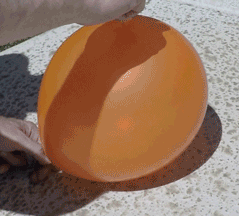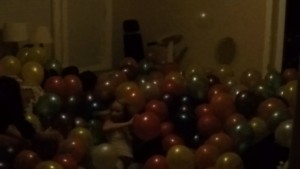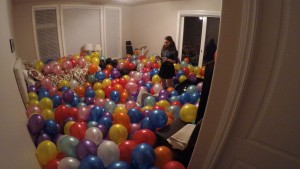For my Popping 700 Balloons video, I was hoping to get some really great pops in slow motion. I wasn’t about to blow up another 700 balloons if I messed up the video, so it was important to get it right the first time. All in all, the results were pretty good, but it took some planning and experimenting to get there.
You Gotta Be Fast To Go Slow
Producing slow motion video is all about recording at as high a frame rate as you can manage so that you get a nice result when those frames are played back at the standard 30 frames per second. Professional high-speed cameras designed for ultra slow motion playback can achieve about 100,000 fps at decent resolutions. Of course, that type of gear will set you back the price of a luxury car.
Until recently, if you looked at the specs of consumer video cameras advertised as “high speed”, you’d find that the maximum frame rate they could handle was 120 frames per second. And often to use that frame rate, you’d have to select a resolution way below the camera’s maximum. More recently, cameras like the GoPro Hero4 Black I was using can record at 240 frames per second at a reasonably good 1280×720 resolution.
Is 240 Frames Per Second Fast Enough?
 If you look at this animated gif made from a test video, you’ll see that 240 fps doesn’t really let you see the balloon pop. There’s a single frame where the balloon has popped but the rubber hasn’t yet fallen to the ground. It turns out that even that much was a lucky coincidence to catch that particular frame in the video sequence.
If you look at this animated gif made from a test video, you’ll see that 240 fps doesn’t really let you see the balloon pop. There’s a single frame where the balloon has popped but the rubber hasn’t yet fallen to the ground. It turns out that even that much was a lucky coincidence to catch that particular frame in the video sequence.
This was recorded at 240 fps and is being played back at 10 fps, or 1/24th actual speed. The real elapsed time for what’s shown in the snippet here was only 1/6th of a second.
For my purposes, slow motion recorded at 240 fps would still be fun, and I didn’t have the equipment to do better anyway, so I decided to proceed. If your aim is even slower motion, say for measurements or analysis, consider this one data point to help make your frame rate decision.
Let There Be (A Lot Of) Light
 As a simple test to see how good slow motion video would look in the room full of balloons, I recorded a few minutes. Here is one of the frames from that video. That’s horrible! At 240 frames per second, not very much light gets captured for each frame. This room has a reasonably-bright overhead light fixture with three 60W, unshaded bulbs.
As a simple test to see how good slow motion video would look in the room full of balloons, I recorded a few minutes. Here is one of the frames from that video. That’s horrible! At 240 frames per second, not very much light gets captured for each frame. This room has a reasonably-bright overhead light fixture with three 60W, unshaded bulbs.
 For comparison, here’s a frame from a 30-fps video taken in the same room about two minutes later with no lighting changes.
For comparison, here’s a frame from a 30-fps video taken in the same room about two minutes later with no lighting changes.
One of the best ways to get lots of light is to film outside on a bright, sunny day. Additional lights or reflectors can be used to make the lighting more even and remove shadows, but they don’t really add much brightness. So in my series of experiments, I started outside around noon with a totally clear sky. This at least gave me a sense of how good the high frame rate video could get, even if filming outdoors wasn’t a practical option in this particular case.
Test #1
This is the baseline test outside in bright sunlight. For each test, I recorded at the highest available frame rate for the given resolution, and didn’t bother with anything below 120 fps. For playback, I selected normal speed, 1/4 speed, and 10 frames per second. The video here provides good examples of the GoPro’s combinations of resolution and field of view.
Test #2
This next video compares three different indoor lighting conditions while recording at 240 fps and 1280×720 resolution.
It’s pretty clear that you probably can’t have too much light when shooting at higher frame rates. Based on these tests, I used every light I had.